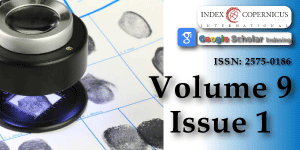Forensic Science in Pediatric Dentistry: Collect Preserve & Analyse: A Review
Main Article Content
Abstract
Dentistry has much to offer in the detection and solution of crime or civil proceedings. Forensic dentistry requires an interdisciplinary knowledge of dental science, and it is the role of the Forensic Odontologist to establish a person's identity. Teeth, with their physiologic variations, pathosis record information that remains throughout life and beyond. Forensic Odontology has an important role in the recognition of abuse among children. Teeth may also be used as a weapon against children, and physical evidence such as DNA, bite marks, fingerprints may objectively link suspects to a crime and develop important investigative leads. Gender identification and sex determination by analyzing the pulp tissue in primary teeth can be regarded as an effective tool in providing valuable forensic information. The rights of children and their aspirations are of paramount importance, and the Pediatric dentist can contribute immensely to the field of Forensic Odontology in providing justice to these unfortunate children.
Article Details
Copyright (c) 2025 Mahesh P

This work is licensed under a Creative Commons Attribution 4.0 International License.
Phillips M. The role of forensic dentistry in South Africa. Med Law. 1993;12(6-8):487-91. Available from: https://pubmed.ncbi.nlm.nih.gov/8183057/
Syrjanen SM, Sainio. Forensic dentistry—recent development towards an independent discipline in modern dentistry. Proc Finn Dent Soc. 1990;86(3-4):157-70. Available from: https://pubmed.ncbi.nlm.nih.gov/2094849/
Dinesh KT. Journal of Oral and Maxillofacial Pathology. 2017;8(2):136-8.
Ganswindt M, Ehrlich E, Klostermann P, Troike WG, Schneider V. Bone finds: a challenge to forensic science. J Leg Med. 2003;(1):382-5. Available from: https://doi.org/10.1016/s1344-6223(02)00137-2
Whittake DK, Llewelyn DR, Jones RW. Sex determination from necrotic pulpal tissue. Br Dent J. 1975 Nov 18;139:403-5. Available from: https://doi.org/10.1038/sj.bdj.4803645
Davis EC, Ireland EJ, Carr R. Implementations of forensic dentistry in criminal investigations. Eur Sci J. 2014;10:196-9. Available from: https://doi.org/10.19044/esj.2014.v10n24p%25p
Monika B, Ann-KZ, Jochen H, Katja P. Forensic dental age estimation: development of new algorithm based on the minimal necessary databases. J Pers Med. 2022;12:1280. Available from: https://doi.org/10.3390/jpm12081280
Atreja G. Cheiloscopy and palatoscopy. In: Textbook of Forensic Odontology. India: Jaypee Brothers Medical Publishers; 2013;155-68. Available from: https://www.jaypeedigital.com/book/9789350257227/chapter/ch7
Vinutha YJ, Krishnapriya V, Shilpa G, Vasanti D. Forensic dentistry: a pedodontist’s perspective. J Med Radiol Pathol Surg. 2015;(1):8-14. Available from: http://dx.doi.org/10.15713/ins.jmrps.9
Sharma G, Yadav D, Singh H, Aggarwal AD, Sandhu R. Bite mark analysis: an important tool in crime investigation. J Indian Acad Forensic Med. 2006;28:69-91. Available from: http://dx.doi.org/10.1177/0971097320060209
Stavrianos C, Tatsis D, Stavrianou P, Karamouzi A, Mihail G. Intercanine distance as a recognition method of bite marks induced at cases of child abuse. Res J Biol Sci. 2011;6:25-9. Available from: http://dx.doi.org/10.3923/rjbsci.2011.25.29





